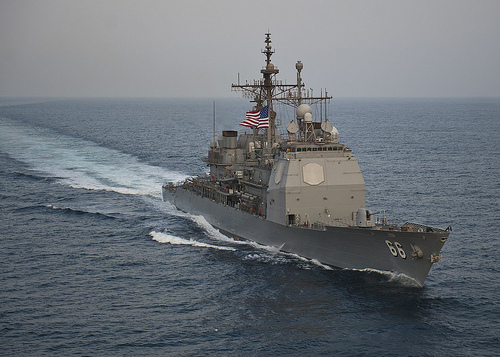Top White House officials dismissed a Sunday announcement that Syria had agreed to allow United Nations investigators access to sites of Wednesday’s alleged chemical attacks, declaring that the development is “too late” in what appears to be a hardening U.S. stance.
“If the Syrian government had nothing to hide and wanted to prove to the world that it had not used chemical weapons in this incident, it would have ceased its attacks on the area and granted immediate access to the U.N. five days ago,” a top U.S. official declared Sunday. “At this juncture, the belated decision by the regime to grant access to the U.N. team is too late to be credible, including because the evidence available has been significantly corrupted as a result of the regime’s persistent shelling and other intentional actions over the last five days.”
President Barack Obama met with his national security team Saturday, and the Pentagon is moving naval forces closer to Syria, in what appear to be preparations for potential direct attacks following allegations of chemical weapons use in the outskirts of Damascus, despite murky details surrounding the alleged attacks and stern warnings against intervention from experts.
As evidence mounts that a chemical attack did take place Wednesday, the government of president Bashar al-Assad and its opponents both charge that the attack was launched by the other side, and to date no independent body has verified who caused the at least 355 reported deaths. Experts warn that, in a situation mired in complexity and competing propaganda wars, it would be a grave mistake to draw conclusions before the facts are clear.
As Syria’s ally Russia urges Assad to cooperate with UN officials investigating the potential chemical weapons attacks, who have so far been barred access, the UK and France are loudly voicing their suspicions that Assad was behind the deaths.
While the U.S. government acknowledges that it still does not know what happened, Obama instructed the Department of Defense to move forces closer to Syria, and at least four U.S. ships armed with missiles are now positioned in the Mediterranean sea, in what appears to be an escalation of aggression but not a foregone conclusion that strikes will take place.
“The Defense Department has a responsibility to provide the president with options for contingencies, and that requires positioning our forces, positioning our assets, to be able to carry out different options — whatever options the president might choose,” Defense Secretary Chuck Hagel stated Friday.
While some in the U.S. government, including Senator John McCain (R—Ariz.) and Senator Lindsey Graham (R—S.C.), call for intervention, many in the Obama administration previously appeared hesitant, including top-ranking military officer Joint Chiefs of Staff General Martin Dempsey who delivered a stern warning this week against strikes, declaring “It is my belief that the side we choose must be ready to promote their interests and ours when the balance shifts in their favor. Today, they are not.”
Meanwhile, policy experts and peace advocates caution against a rush towards intervention, arguing there is no military solution to Syria’s humanitarian crisis that is fueled by the escalating militarization of Syrian society.
Robert Naiman, policy director for Just Foreign Policy, told Common Dreams that the Obama administration’s latest steps, clearly designed to make strikes possible, increase the chances of direct intervention but do not make it certain.
“The chances of military escalation are higher,” Naiman told Common Dreams. “But the U.S. has backed off before, and they know what we know: that there is no silver bullet, and U.S. military escalation is likely to create further catastrophe.”
“People should be concerned when the administration makes an aggressive gesture, but it does not mean that they are planning to bomb,” he added. “That means military escalation can still be stopped.”
Sarah Lazare is a staff writer with Common Dreams, where this article originally appeared. It is reprinted here with permission.
Photo: TimWebb / flickr



